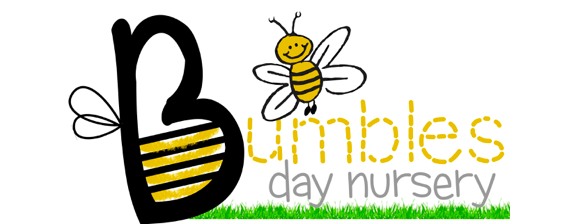A day in the life of a Bumblebee...

Bumbles Day Nursery holds up to 71 children at any one time. We cater for all ages between 6 weeks and 5 years old with well trained and experienced staff tailored for every room.
A variety of stimulating toys and equipment are available for your child and all rooms have excellent visual effects that are constantly changed and updated so that they will entertain children and keep a child’s mind alight, not only with decoration but the equipment stored within.
We have an excellent supply of fun and educational learning aids. There are plenty of opportunities in the basic daily routines for imaginative and enriching play, whether it is painting, gluing, playing on the slide or building a brick castle.
Our play areas are separated into four different age ranges, each room is named after a flower that are popular with Bumblebees (of course!);
4 weeks to 14 months - Buttercups
14 months to 2 years - Snowdrops
2 years to 3 years - Poppies
3 years to School - Sunflowers
Sensory Room
Please read below for a brief description of each room.
Buttercups
The baby room at Bumbles Day Nursery provides warmth, fun and security for children under 1 year old. The bright and spacious room allows staff to provide the appropriate activities for your child’s age group and developmental stage. It is important for children of this age to receive continuity of care between nursery and home therefore the nursery staff will ensure your child’s familiar routine is maintained. The staff encourage the babies to freely explore and enjoy their play activities in a safe, relaxed environment allowing them to develop their confidence, independence and learning.

Snowdrops
In our toddler room the Early Years Foundation Stage is used by our nursery staff to provide the quality experiences your child needs at this stage as they begin to assert their independence and individuality. A wide range of creative, messy and fun indoor and outdoor activities will stimulate and encourage your toddler to develop and exceed.

Poppies
Children of this age group will be encouraged and supported to self-register.
The children have the opportunity to further develop their skills through challenging and exciting activities including sensory play, such as painting, playdough and Music Time.
Children are able to explore the indoor and outdoor learning environment through free flow play, accessing resources and activities of their choice. Children are encouraged to develop their gross motor skills by using wheeled toys and outdoor climbing equipment.
As children approach their 3rd Birthday they will begin to make regular visits to Pre-school, thereby helping to assist the children with a smooth and comfortable transition.

Sunflowers
Children experience a wide and exciting range of activities that are freely and easily accessible throughout the sessions. These include adult led rhyme and rhythm activities during ’Music and Movement Time’ and fun filled opportunities to play percussion instruments.
A wide selection of resources are offered and are available for the children to self-select, which promotes independent learning. Sunflowers also have direct access to our outdoor play area.
The library bus will also be visiting once a month and the children are encouraged to board the bus to choose books, including a short ‘Storytime Session’ by The Librarian. The children also have use of an extended variety of art and craft materials and mark making materials, to promote their fine motor skills in preparation of starting school.

Sensory Room
At Bumbles we have a well resourced and stimulating sensory room. The room is blacked out using specialist curtains and blinds and is filled with water toys, bubble machines, glow in the dark resources and many more. This is used by all children attending, whether they visit as an individual or a small group. Bumbles believes in working in partnership with the local children centres and wider community by providing a wide range of services for all children. To promote this we will allow outside settings to use the sensory room on a pre-booked basis.
Sensory play has an important role in development. When you talk about the senses, most children over a certain age can explain what they are without problem: sight, smell, hearing, touch, and taste. Any and all of these can be incorporated into sensory play.
The Role of Sensory Play
There are certain groups of children who will benefit more from sensory play, however, all children need help learning how to use their senses.
From the very first day they are born, children are designed to explore the world via their senses. That's why babies and toddlers touch everything and put it in their mouths. It's why children make funny noises with their mouths and experiment with how the world sounds with their fingers stuck in their ears. It's why your child spins in circles until they’re so dizzy, they falls and then get up and do it again.
Sensory Play Isn't All About Touch
Some people, when they think of sensory play, immediately picture sand and water tables or children playing with clay and playdough. But sensory play isn't all about touch, it's also about the other senses too.
For instance, the sharp scent of vinegar involved in a science experiment or the colours of water during a color mixing experiment or the texture and smells of scratch and sniff painting are all part of appealing to your child's senses.
Sensory exploration is a child's way of examining, discovering, categorising and making sense of the world. And it's beneficial to provide them with opportunities for sensory play.
Sensory Play and Language Skills
Playing with different types of textures and tasting and objects help your child build new ways of talking about the world.
Suddenly the tree is more than a tree, it's a sapling with smooth bark, or it's a pine tree with rough bark and a sharp pine scent. Water isn't just wet, it can be rough (waves) or slippery with bubbles or cold and translucent when frozen or clear and still.
Tastes, too, can build your child's language base. No longer do they want hot dogs for dinner, but they want something tangy or salty or sweet, but certainly not bland or bitter.
Sensory Helps Fine Motor Skills
There are two main types of motor skills your child develops--fine motor and gross motor skills. Gross motor skills deal with the co-ordination of large muscle groups and are responsible for activities like running, walking, etc.
Fine motor skills are those that require the ability to use and coordinate small muscle groups. Fine motor skills are important for writing, shoe-tying, buttoning and zipping, among other things. Sensory play often involves using and building fine motor skills by exploring things using pinching, pouring and lacing movements.
Sensory Play is Calming
You may have noticed that your child is calmer after bath time or that after a particularly rough session of jumping around the room, banging into furniture, crashing onto his bed or into pillows, your child seems more grounded. This type of sensory play is calming for children. It helps them regulate their internal discomfort, whether that discomfort was boredom, restlessness or some other type of agitation.

